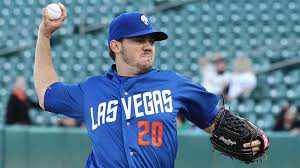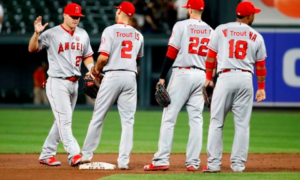Ohtani’s Grand Slam that Should’ve Been

There are no good nicknames for two runners on base, nor are there any for three-run home runs. When there are three runners on, the bases are loaded, jacked, juiced, drunk, or jammed. A bases loaded home run is a grand slam, of course. It has its own Wikipedia page. Three-run homers are still excellent if you’re the batter. They’re particularly special if you hit one in your first home at bat with a new team, in a new league, on a new continent. That’s exactly what Shohei Ohtani did this past Tuesday, begetting the legendary career we all expect of him.
It’s a good narrative, but not a great one. Quick, think of the most famous three-run home run you can remember. It takes at least a few seconds. We tend not to remember who’s on base for a lot of famous homers. But if you think about grand slams, it’s a little easier. They are a class unto themselves. It was a big deal when Alex Rodriguez broke Lou Gehrig‘s career grand slam record (which is 25 by the way), but you probably don’t know hit the most career three-run bombs. Neither do I. For this entirely unimportant reason, Ohtani’s home debut three-run home run was cheapened, just a little.
The Difference Between 3 Runs and 4
It’s not Ohtani’s fault that he didn’t hit a grand slam; he has no control what happens to the batters or runners in front of him. But a grand slam would’ve made such a great story, especially since the bases WERE loaded when he first approached the plate! On the fourth pitch of the at bat, Indians pitcher Josh Tomlin unleashed a wild pitch, allowing the runner on third to score and the other runners to advance. Two pitches later, Ohtani smashed a hanging breaking ball over the right-center field fence.
The wild pitch doesn’t matter whatsoever in the outcome of the at bat, the inning, or the game. Four runs still scored. Statistically, the only difference is Ohtani gets 3 RBI instead of 4. But narratives are the fuel that drive the splendor of baseball. It’s the difference between Derek Jeter and Mike Trout. Jeter is a future Hall of Famer, but he’s not nearly as phenomenal as Trout (neither is anyone else for that matter). But Jeter had so many signature moments: the diving catch into the stands, the flip, the November home run. Trout, for all his indescribable brilliance, has yet to create a single memorable moment like Jeter’s. He’s still got time to hit an All-Star Game walk-off or make a series-clinching diving catch. These are the moments we live for as baseball fans; the ones we tell our grandchildren about.
In this regard, Ohtani already has a leg up on Trout. There’s something special about a home opener, even moreso a home debut, and making a mark with a home run is a story worth passing down. It has the potential to be an “I was there when..” story for Angels fans. However, a grand slam would have been just that much more memorable. Perhaps the most bizarre thing about the whole story is that we were robbed of this perfect moment by the least likely pitcher on the planet to throw a wild pitch.
One Good Thing About Josh Tomlin
Josh Tomlin is not a great pitcher. He’s pretty good though, and he’s stuck around the middle of a major major league rotation for 9 years, injuries notwithstanding. That certainly qualifies as a successful career, which is something of a miracle given his peripherals. His career average fastball velocity is merely 89.1, and he manages only a 16.4 K%. Both of these are among the worst in MLB over the span of his career. Furthermore, he’s quite prone to home runs, yielding 1.6 of them for every 9 innings. These numbers tell the tale of pitcher who shouldn’t be in the big leagues at all, much less for 9 years.
There is only one reason why Tomlin sticks around in the majors: absolutely pinpoint control. Just 122 of the 3,449 men who have stood in the batters box against him have received a free pass to first base, and 13 of them were intentional. That’s just a 3.5% walk rate; the league average was 8.5% in 2017. He led the league in BB/9 in the only two seasons he had enough innings to qualify: 2011 and 2016. In fact, he’s the only player in baseball since 2010 to give up more home runs than walks (minimum 25 HR allowed).
Tomlin is the best control pitcher in baseball, even if he doesn’t do a lot of other things well. As you might expect of a precision pitcher such as this, wild pitches are exceptionally rare. The wild pitch he threw during Ohtani’s at bat was only the 21st of his career. Through Tuesday’s action, he has thrown 12,570 major league pitches. Only 0.17% are so out of control that the catcher could not handle them. Inexplicably, one of those wild pitches cost Ohtani a grand slam.
The Story of Ohtani
On April 8, 2003, Hideki Matsui hit a grand slam in his Yankee Stadium debut. He had migrated to New York after an all-time great career in Japan. With two worlds watching, he wrote a legendary tale and forever etched himself into the memories of adoring fans. Whatever the hell that means. Matsui couldn’t control the three runners in front of him reaching base any more than Ohtani. If Twins pitcher Joe Mays had thrown a wild pitch before Matsui connected, would his story still carry the same reverence?
Shohei Ohtani is only 23-years-old. He’s got as much talent as anyone else in the baseball world. Hitting isn’t even what he does best! He could become a one-of-a-kind, incomparable Hall of Famer. He could flame out completely or get injured. Did we witness his greatest moment on Tuesday? If so, it’s a shame “three run home run” doesn’t roll off the tongue quite as nicely as “grand slam.” The most precise pitcher on the planet inexplicably missed his catcher entirely with a pitch, and the altered Ohtani’s story forever.
-Daniel J. Epstein


















